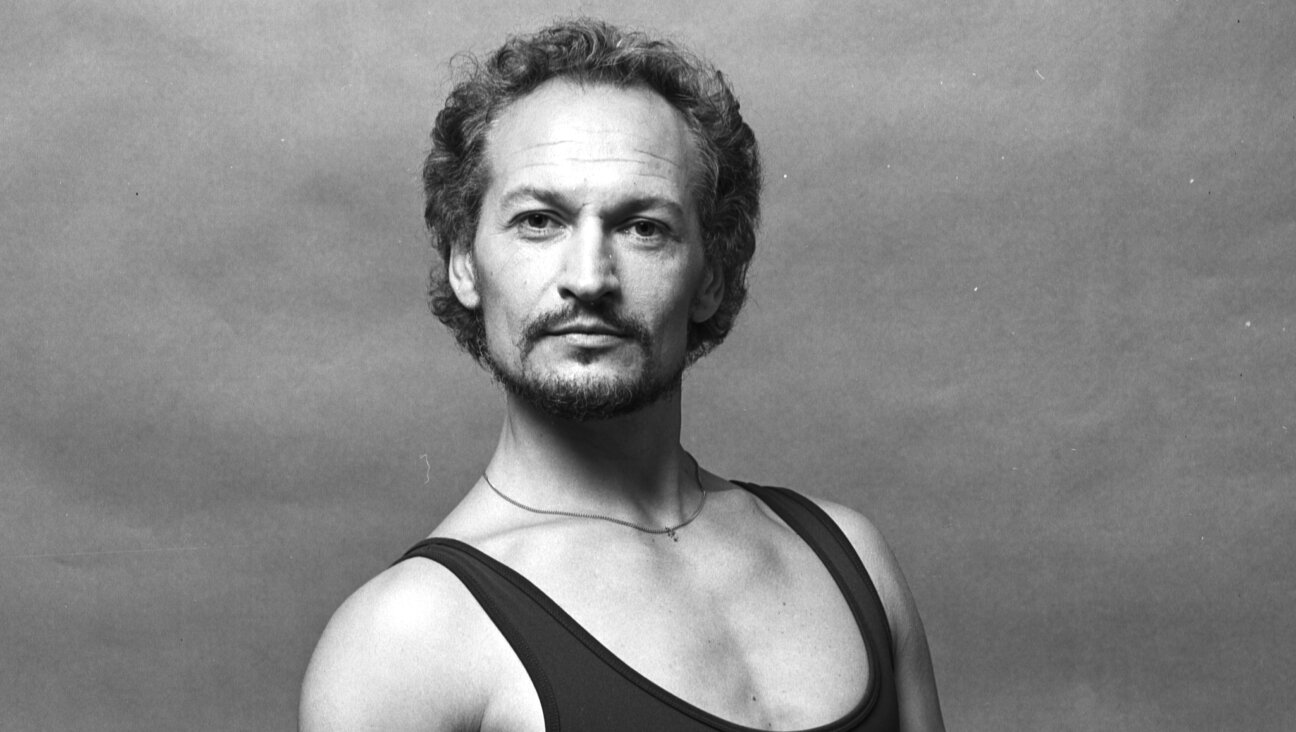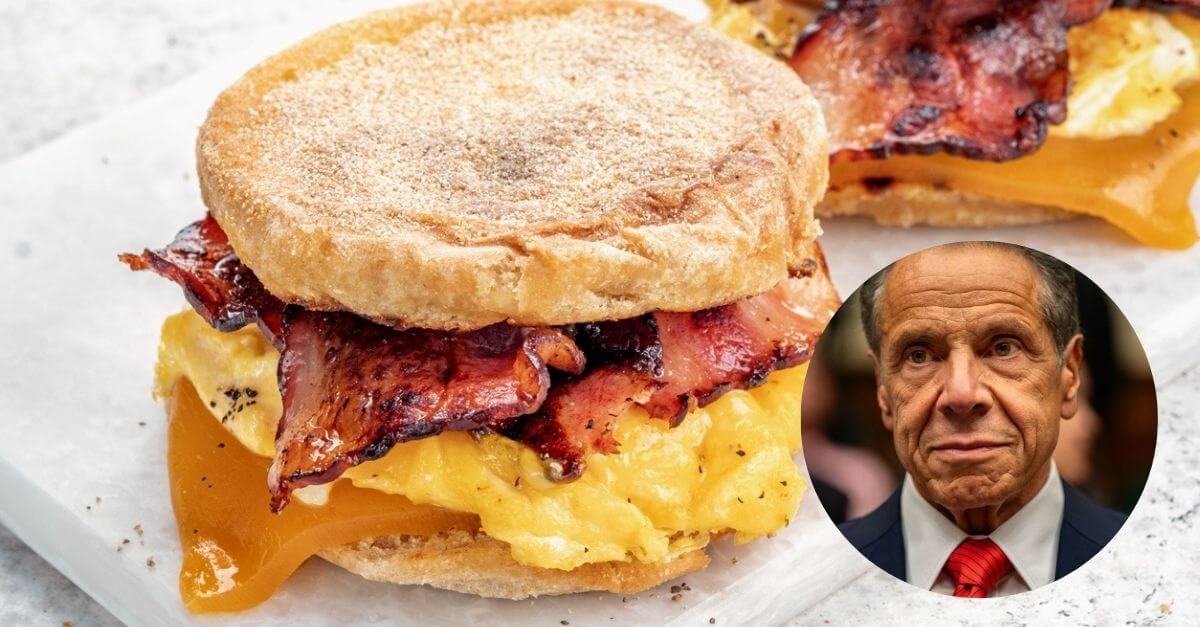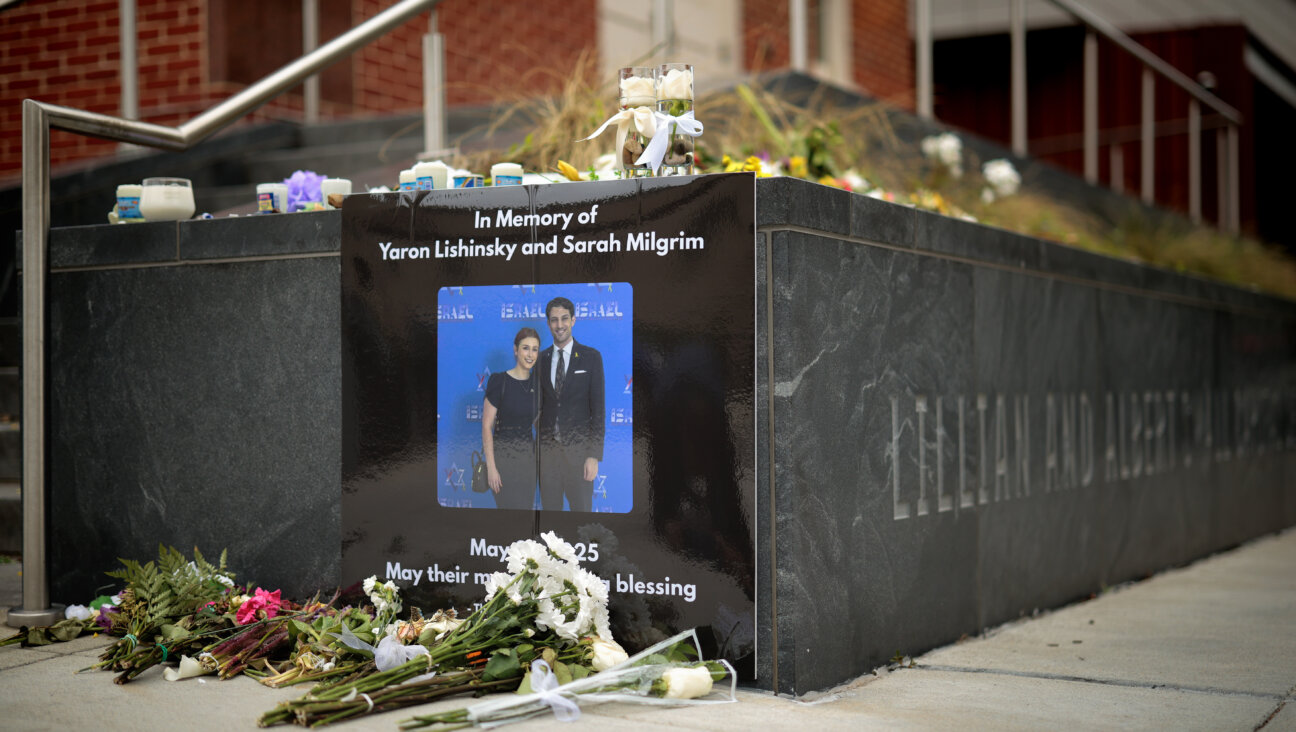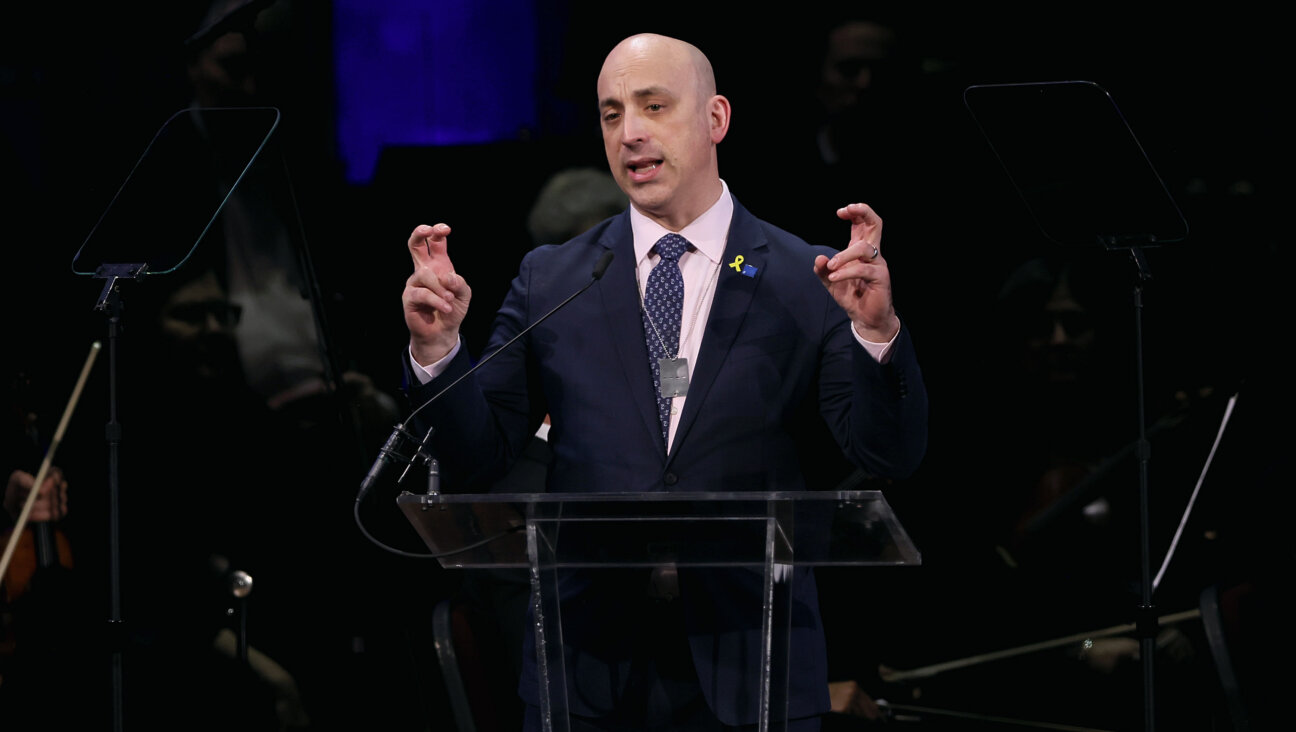What I Learned From Interviewing Ruth Bader Ginsburg, Supreme Court Superhero

Image by Ron Sachs
Follow Ruth Bader Ginsburg onto a stage, and you will have an extraordinary experience. It’s not that she makes a grand entrance. Quite the contrary — her frame is so tiny, her gait is so slow, that she appears to want to slide meekly into a room rather than take it by storm.
But then a roar arises, the kind of vocal adulation usually reserved for a Springsteen or a Streisand, or maybe Oprah when she’s giving out cars, and suddenly the audience in a cavernous auditorium is on their feet before she says a word, before she even reaches the stage, clapping and cheering as if this diminutive, brainy wisp of a woman a month shy of her 85th birthday has magical powers of salvation.
It can make you choke up a bit, this overwhelming adoration.
It did that to me.
This experience, in early February at Adas Israel synagogue in Washington, D.C., where I had the privilege of interviewing Ginsburg, is undoubtedly repeated whenever the well-traveled justice speaks. She must be the most unlikely celebrity of our time. In the past five years, Ginsburg has attained star status not only among older Americans, Jews especially, who consider her the last bulwark against Trump-aggedon, but also among a wave of younger people — girls and women in particular — who seek her advice, dress up as her for Halloween, buy her swag, study her life, and see in her a real-life heroine on a plane high above the Washington swamp.
Unlikely though it may seem, this scholarly, soft-spoken Jewish great-grandmother represents a powerful archetype: The child of immigrants, Ginsburg, through smarts, courage and perseverance, rose to the apex of her profession and never forgot where she came from. There is a consistency and authenticity to Ginsburg’s life story and accomplishments that appeals to anyone who still wants to believe this is how America is made.
And in the twilight of her life, while still vibrant and aware, she is obviously embracing this cult status to ensure not merely her own legacy, but also that of the ideals and judicial philosophy she represents.
Not everyone worships her this way, of course. Her detractors disagree with not only her staunchly liberal judicial perspective, but also her occasional outspokenness; her critique of Donald Trump during the 2016 campaign prompted him to call on her to resign, and drew disappointed reactions even from some supporters.
She is more circumspect now in public, adhering more strictly to the rule that she not be asked about politics, or legal issues that are or may be before the high court. Still, that reticence has not dampened her celebrity one bit.
In managing this fame, it does help to be a judge on the high court — forbidden from overt politicking, unblemished by fundraising, cosseted in a job with lifetime tenure that cannot be revoked unless she behaves very, very badly. Appointed by President Clinton in 1993, Ginsburg is the oldest justice among her eight colleagues, and the longest-serving Jewish justice ever. She says adamantly that she has no plans to retire.
“So many people have asked me, ‘Well, when are you going to step down?’” she said during our interview. A cry of “Never!” immediately rose from the audience.
She relayed a series of self-imposed deadlines that she subsequently ignored. She would wait until a beloved painting was returned to her chambers; it was, and she’s still there. She would wait until she surpassed other long-serving Jewish justices, Louis Brandeis and Felix Frankfurter; she has, and she’s still there.
She no longer pretends: “I’m just candid and say as long as I can do the job full steam, I will be here.”
‘I grew up in the shadow of World W II’
Ginsburg’s tenacity is a fundamental part of her allure, and her character. She was born in Brooklyn to a Russian immigrant father and a mother conceived in the old country but born in the new. Her childhood was marked by tragedy and struggle. She was only 14 months old when her 6-year-old sister, her only sibling, died of meningitis. Her beloved mother, Celia Bader, was stricken with cancer during Ginsburg’s first year at James Madison High School and did not live to see her daughter accept high honors at her graduation. Ginsburg did not attend the ceremony, either; her mother had died two days earlier, and she was home with her grieving father.
Excelling in school became both a salvation and a concrete way of granting her mother’s fervent wishes. “My mother was a hugely intelligent woman,” she told me. “She emphasized two things. One was that I should be a lady. And by that she didn’t mean fancy dress. What she meant is, be in control of your emotions and don’t give way to anger, to remorse, to envy, those emotions just sap strength…. And her other message was, be independent.”

Ruth Bader Ginsburg displays her “I Dissent” tote bag. Image by Ron Sachs
While not religiously observant, the Bader household practiced the kind of a la carte Judaism common in that generation, with an emphasis on joyful family rituals — Hanukkah parties, Passover Seders — and liberal-minded intellectualism. The open-mindedness did not extend, however, to gender parity, and young Ruth learned early on the persistent differences in how boys and girls were treated.
She jokes about it now. “I wanted to have a big party for a bat mitzvah and get all those presents!” she said with a laugh. “I grew up with a cousin. We lived in the same household — two sisters married two brothers who were three months apart. We were like twins and he was bar mitzvahed. And had this great party. And all the gifts. I was very jealous.”
But in all seriousness, the emerging awareness of the Holocaust shaped her Jewish — and judicial — consciousness.
“I grew up in the shadow of World War II. And we came to know more and more what was happening to the Jews in Europe. The sense of being an outsider — of being one of the people who had suffered oppression for no sensible reason… it’s the sense of being part of a minority. It makes you more empathetic to other people who are not insiders, who are outsiders.”
That sense of being an outsider, of identifying with minorities and viewing the law as their protector, propelled her judicial activism at Harvard and Columbia law schools, through decades of arguing cases, teaching law at Rutgers and Columbia, and ruling from the bench. And yet, paradoxically, through dint of hard work, notable courage and the shrewd lobbying of Marty Ginsburg, her savvy husband, Ginsburg achieved the highest “inside” position in her field when she was easily confirmed 96–3 as only the second woman ever to be appointed to the Supreme Court.
For this, she credits the classic American dream. In a 2009 speech examining the history of Jewish justices, she asked: “What is the difference between a New York City garment district bookkeeper and a Supreme Court justice? One generation. My life bears witness, the difference between opportunities open to my mother, a bookkeeper, and those open to me.”
Working within the system
You want another reason Ginsburg is an icon to Jews? Here are two stories she related in our interview.
There hadn’t been a Jewish justice since Abraham Fortas resigned in 1969, and early in Ginsburg’s tenure, one of the clerks came to her with a problem: It seemed that the official certificate for acceptance in the Supreme Court bar said “in the year of our Lord,” and Orthodox Jews objected, since the Lord in question was Jesus Christ.
“So, I spoke to the chief about this, and he said we’ll take it up at conference,” Ginsburg recounted. “And one of my colleagues, and I will not disclose who, said, ‘In the year of our Lord was good enough for Brandeis, it was good enough for [Benjamin] Cardozo, it was good enough for Frankfurter, it was good enough even for [Arthur] Goldberg.’ And before he got to Fortas, I said, ‘It’s not good enough for Ginsburg!’”
And so the language was changed in order to give lawyers a choice. When the crowd at Adas Israel heard this, they cheered.

Jane Eisner and Ruth Bader Ginsburg in conversation. Image by Ron Sachs
Ginsburg clearly loves to tell stories.
“The next was the great Yom Kippur controversy,” she went on, warming to the theme. The court’s session begins on the first Monday in October, but in 1995, that coincided with Yom Kippur. Justice Stephen Breyer was the only other Jew on the court at the time, and he and Ginsburg asked Chief Justice William Rehnquist not to go into session that day.
“The argument,” she said, “that was utterly convincing for the chief was that inevitably in an argument session there will be Jewish lawyers and… this is their day at the Supreme Court. Do you want to take away from them the opportunity to present their case and require them to have a substitute?
“And that resonated, and so now we don’t sit on High Holy Days.”
Another cheer from the crowd.
She’s a champion, but not a loud one, willing to work within the system. When appointed to the Supreme Court, she was actually considered a moderate; two months before Clinton named her, she famously criticized Roe v. Wade for being “too swiftly shaped.” (She declined to discuss abortion in our interview.)
Today, even as the leader of the staunch liberal wing of the Roberts Court, so often in the minority on consequential decisions, Ginsburg embodies a deeper bipartisanship rooted in a devotion to the incrementalism inherent in seeking change through the law. The Supreme Court, she says, is the most collegial place she’s ever worked. Even now, with justice Antonin Scalia gone.
Scalia, of course, was her ideological nemesis and close personal friend, a relationship that preceded their time on the Supreme Court. You can find a photograph of the two of them atop an elephant during a judicial conference in India in 1994. The Scalias and Ginsburgs were so fond of each other that after Marty Ginsburg died in 2010, Scalia openly wept in court.
Given the vicious polarization in Trump’s America, there’s a yearning to decode the secret of this mysterious friendship. I asked her about it.
“We shared certain things,” she recalled. “One is, he was brought up in Queens. I was brought up in Brooklyn in roughly similar neighborhoods, where people were either Irish or Italian or Jewish. We both really cared about families. We had an annual New Year’s party where the fare would be whatever, you know, [he] hunted. So usually it was Bambi. And my husband, who was a great chef, made venison. And whatever children were around came. And then we shared a love of opera.”
But there was more — a professional collaboration both respectful and honest. They used to show each other their opinions, offering frank criticism and, on Scalia’s part, grammatical corrections. And there was a devotion to higher values. When I pressed her about the broader lessons of her friendship, she replied: “Well, I think it is our caring about the welfare, the good and welfare of the court. And anybody who is in a decision-making body, that should be the No. 1 priority.”
Indeed.
Notorious RBG
So how did this stooped, studious women with the raspy voice and the unobtrusive demeanor become transformed into the glorious, Notorious RBG — satirized on “Saturday Night Live,” star of a documentary released at Sundance, the subject of a feature-length film, a justice whose face adorns T-shirts and mugs and tote bags, and who is the idol of girls and women everywhere?
Ginsburg traces the start of her celebrity to the 2012–2013 term when she broke a half-century-long record and read five dissents from the bench. In particular, her scathing dissent in the Shelby County case that she believed cut the heart out of the Voting Rights Act prompted a law student, Shana Knizhnik, to create a Tumblr blog in her honor. And the rest is, as they say, marketing history.
But her emergence also occurred in the aftermath of the death of her husband of 56 years, and theirs was a true partnership in every sense of the word. He was the more socially gregarious of the two, the one who pushed her to lobby for a nomination to the court, who was secure enough to be her biggest champion.
With him gone, she champions herself.
The adulation clearly nourishes her, and she drinks from it, often. The week before our interview, she spoke in Providence, Rhode Island; the week after, in Manhattan and Philadelphia. Other Supreme Court justices give speeches when the court is not in session, of course, but Ginsburg’s schedule is more like that of an aging rock band still ardently followed by its fans, eager to hear the music one last time. Adas Israel seats about 1,400 people in its sanctuary, and the tickets to the Forward event sold out in a matter of days.
Why? Ginsburg gains no money from these speeches. Her legacy is fully formed. As Justice Elena Kagan, appointed in 2010, once noted, “More than any other person, she can take credit for making the law of this country work for women.”
My impression is that she uses her fame to revert back to her days as a law school professor, eager to impart certain lessons to a public starved for learning and inspiration. Listen to enough of her interviews, as I have, and you’ll find she tells the same stories about the same cases again and again. Perhaps that’s because such repetition is most comfortable for an aging mind. But I think it’s because she wants us to know — to know that just a half-century ago, gender discrimination was so baked into state and federal laws that it took a steady stream of targeted legal actions to undo it. And to know that challenges to the rights of women and minorities persist today.

9-year-old Carly Rae Brown, a fan of Ginsburg, hopes to be her successor. Image by Courtesy of the Brown Family
This consistency, I’m convinced, is one of the reasons that even young girls find her so heroic. Overt gender discrimination has been banished from the law, but even Carly Rae Brown, a 9-year-old Indiana fourth-grader who sent in a question to the Forward, knows that there is still work to do. CRB, as she likes to be known, comes from a Catholic family in the heartland, and nonetheless identifies so strongly with the bubbe from Brooklyn that she asked for advice on how to be her successor.
“It’s amazing to me,” Ginsburg said toward the end of our interview. “In March I will be 85, and everyone wants to take my picture.”
Jane Eisner is the Forward’s editor-in-chief. Contact her at [email protected]























